Abydos - Temple of Seti I
The town and district of Abydos is located west of the Nile, on the border between the valley and the desert some 145 km from Luxor. It was here that the ancient
kings of Egypt were buried and from predynastic times the area grew to become
an important religious centre. It is particularly associated with Osiris, one
of the great gods of Ancient Egypt, one of whose epithets is the "Lord of
Abydos." His mysteries were celebrated there annually and the ritual
re-enactment of Osiris' death and resurrection brought pilgrims from all over
Egypt.
The Temple of Seti I
The area boasts a number of temples the most significant
of which was built by Seti I in the XIX Dynasty. His cult
temple is the largest of the Abydos temples, built of limestone
and sandstone blocks to an unusual L-shaped plan, it has seven
sanctuaries instead of the usual one (or three). The temple
was not completed by the time of Seti’s death and was finished
by his son Ramses II.
The quality of carvings In this temple, particularly those from
the time of Seti, are of a very fine order. The temple also
holds a number of mysteries some of which are, perhaps, the
invention of a rich imagination and others merit real
attention.
The Helicopter Mystery
A few years ago a suggestions was made that one of the
hieroglyphs showed the pattern of a modern helicopter. This was immediately
seized on by ufologists to suggest that the ancient Egyptians had contact from
space beings. Sadly expert advice indicated that the seeming helicopter was the
result in the change of hieroglyphic inscription that followed the ascension of
Ramses II to the throne of Egypt. Information on this subject can be found at
the following website: http://www.finart.be/UfocomHq/usabydos.htm
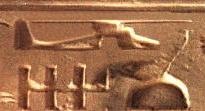 The supposed helicopter The supposed helicopter |
|
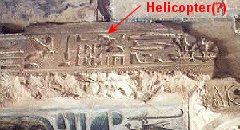
The helicopter can just be made out under the large ceiling crack.
|
Evidence of Energy Healing
More tantalising is the relief of the goddess Hathor on the north wall of the 2nd Hypostyle Hall. Hathor is shown with the ‘water sign’ symbol over her hands. The is one of the commonly used hieroglyphs of Ancient Egypt and symbolises the action of wind over water, which is why it has
become known as the water sign. There is a curious parallel here with Feng
Shui, which when literally translated means ‘wind and water’. On the surface
then it would seem as though Hathor was offering ‘water’ with it’s life giving
essence to the king. is one of the commonly used hieroglyphs of Ancient Egypt and symbolises the action of wind over water, which is why it has
become known as the water sign. There is a curious parallel here with Feng
Shui, which when literally translated means ‘wind and water’. On the surface
then it would seem as though Hathor was offering ‘water’ with it’s life giving
essence to the king.
However if we delve a little deeper into the symbolism of
this sign, which looks very much like an electrical charge on an oscilloscope,
it is clear that two distinct elements - wind and water - are involved or, more exactly the unseen moving the seen. Could this therefore be a symbol of the action of the invisible world on the physical universe? |

Relief showing the goddess Hathor offering the 'water sign' to the king
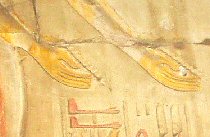
Detail of the above relief.
|
Kinesiology and the 'Water Sign'
A few years ago Dee Jay Nelson and David Coville carried out a number of kinesiology tests using a copper version of this symbol  to see what effect it had on the
energy fields of the body. There work was published in Life Force in the Great Pyramids. They discovered that when this sign was held in the hand, as
demonstrated by our goddess, the subtle energy fields of the body were
considerably strengthened. to see what effect it had on the
energy fields of the body. There work was published in Life Force in the Great Pyramids. They discovered that when this sign was held in the hand, as
demonstrated by our goddess, the subtle energy fields of the body were
considerably strengthened.
This same sign can be also seen in the hands of another goddess in the tomb of Ramses III in the Valley of the Kings. It has been considered that this sign was simply a form of greeting or offering of water (life) to the pharaoh but the inner significance and spiritual message of the hieroglyphs cannot be denied so a deeper explanation is most likely.
The Ancient Egyptians were famed for their magical practices. Perhaps the water sign when held in the hand indicated the transfer of magical or healing energy to the person it was being offered to, which in this case was the king.
We might therefore surmise that this information was known
and understood by the Ancient Egyptians and indicated how healing energy can be
channelled through the hands to help sustain and balance the subtle energies of
another.
King Lists
In one of the corridors to the rear of the temple is the
famous king list of Abydos. This is one of three known king lists and has
helped Egyptologists confirm the reigns of the various kings from the
predynastic period. Not all monarchs are shown in this list the particular
omissions being all of the rulers from the Armana period, which included both
Akhenaten as well as Tutankamen. The highlighted picture shows three famous
rulers from the Old Kingdom, Djedfure, the builder of an unfinished pyramid at
Abu Roash; Kaffre or Chephren, the builder of the second of the Giza pyramids
and Menkaure or Mycerinus the builder of the third of the Giza pyramids. The
cartouches ( ) of these kings show the rendition of their names. These can be
shown as follows:
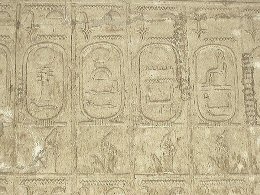 |
Detail of the wall showing four of the kings names which can just be made out. These include: Djedefre; Khafre; Menkaure and Shepseskaf. |
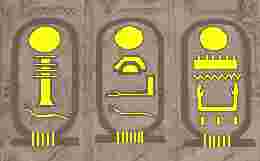 |
Highlighted hieroglyphs from three of the above kings. |
Re is the name of the supreme god who was sometimes also called
Ra. His symbol was the sun, which always appears at the top or first
in the cartouche in deference to his supremacy.
 The Djed symbol represents
the backbone of the god Osiris and
the viper snake because it sheds its skin is seen as a symbol of eternal
life. So we might translate Djedfure’s name as the “The eternal strength
(backbone) of Re” The Djed symbol represents
the backbone of the god Osiris and
the viper snake because it sheds its skin is seen as a symbol of eternal
life. So we might translate Djedfure’s name as the “The eternal strength
(backbone) of Re”
Khafre's name has a phonetic sound
like the ‘ch’ in loch  and is a symbol of the rising sun over the hills at dawn. We might therefore translate his name as ‘The eternal rising Sun of Re.’ and is a symbol of the rising sun over the hills at dawn. We might therefore translate his name as ‘The eternal rising Sun of Re.’
Menkaure's name is a little more complex. The ‘men’  hieroglyph
means stability or balance. The ‘n’ we have already discussed and
here might mean ‘hidden’ or ‘connecting’ resonance. The ka is the
name of the spirit form of a living person and could perhaps be equated
with the spiritualist concept of the ‘etheric’ double. The ‘u’ makes
this plural so we would have to translate this to the ‘spirit forms
of Re’. We might therefore translate Menkaure’s name as “The stability
that comes from the unseen (hidden) energy of the spirit forms of
Re’. This is quite a complex concept captured in a few simple hieroglyphic
signs. Such is the beauty of the hieroglyphic language. hieroglyph
means stability or balance. The ‘n’ we have already discussed and
here might mean ‘hidden’ or ‘connecting’ resonance. The ka is the
name of the spirit form of a living person and could perhaps be equated
with the spiritualist concept of the ‘etheric’ double. The ‘u’ makes
this plural so we would have to translate this to the ‘spirit forms
of Re’. We might therefore translate Menkaure’s name as “The stability
that comes from the unseen (hidden) energy of the spirit forms of
Re’. This is quite a complex concept captured in a few simple hieroglyphic
signs. Such is the beauty of the hieroglyphic language.
The Osirion
At the rear of the Seti temple is another very strange structure called the Osirion that holds some mysteries.
Full details of the Osirion can be found at the following link:
http://www.davidfurlong.co.uk/egypttour_osirion.html
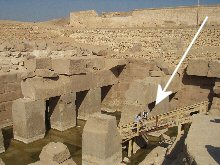 |
|
| The Osirion at the rear of Seti I temple at Abydos. |
The 'Flower of Life' pattern found on a number of the columns in the Osirion. |
Some interesting websites to visit with complementary
information:
http://www.petrie.ucl.ac.uk/digital_egypt/Welcome.html
http://www.akhet.co.uk/mainpage.htm
Does Egypt call to you? Then why not join us for this trip?

For further information please write to:
David Furlong or Frida Maria Myrtles, Como Road, Malvern Worcs WR14 2TH
Tel: +44 (0)1684-569105 or +44 (0)777-978-9047
Email: David Furlong
|
|





